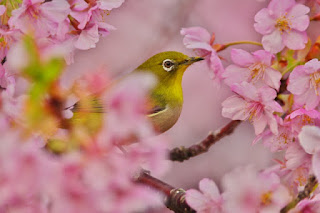A Beginner's Guide To Understanding Haiku...
 |
| Japanese Bush Warbler Curtsy Asia Art |
Look at that warbler –
He’s wiping his muddy feet
All over plum blossom
- Issa 1762 – 1826
Now close your eyes and see if those few words paint the picture…
The above poem by Kobayashi Issa expresses an almost brutal comic contrast and describes a poetic moment so vividly that one could almost see it through Issa’s eyes even after centuries have passed.
I have been reading and writing Haiku for almost 2 decades. Many times I have come across friends, asking "what is HAIKU?" In simple words, Haiku is iconic and most famous poetic form of Japan, (Its also quite popular across the world, nowadays) which conveys a vivid image or a poetic moment within 5-7-5 syllables. I have been explaining through examples, personal discussions as well as through some of my articles about it. But I think to really know what actually "Haiku" is, as well as write one, one has to have a holistic approach towards learning it. So I thought of collating A) My views; B) My readings of various authors; C) My articles published elsewhere about Haiku; D) The essence of Haiku writing; and putting it online, for new admirers of this wonderful poetic form. Finally, after few months of work, here it is, for the beginners in this exquisite journey of painting pictures with word. You will find, in this article, all that is required to understanding and writing Haiku here.
This article is serialized in 4 parts as given below. Each part is complete on its own and one can read in any sequence one likes but I will suggest reading in the order given. This way you will get the whole thing in proper perspective.
 Finally,I hope, this series will help you to understand Haiku better and to relate with this powerful ancient Japanese style of poetry, which is adored by millions of modern readers and writers.
Finally,I hope, this series will help you to understand Haiku better and to relate with this powerful ancient Japanese style of poetry, which is adored by millions of modern readers and writers.
 Finally,I hope, this series will help you to understand Haiku better and to relate with this powerful ancient Japanese style of poetry, which is adored by millions of modern readers and writers.
Finally,I hope, this series will help you to understand Haiku better and to relate with this powerful ancient Japanese style of poetry, which is adored by millions of modern readers and writers.
PART I
I read a beautiful anthology on The Classic Tradition of Haiku – edited by Faubion Bowers. This helped me to look more closely at the classical Haiku and understand its nuances and unravel those subtle hints which help one to complete the vivid image the poet is trying to create…
PART II
 I have also written a feature on Haiku, which was published in an online magazine last year, which essentially gives my own views and thoughts about Haiku and how I became passionate about this amazing form, after reading two very interesting Haiku almost 2 decades back.
I have also written a feature on Haiku, which was published in an online magazine last year, which essentially gives my own views and thoughts about Haiku and how I became passionate about this amazing form, after reading two very interesting Haiku almost 2 decades back.PART III
This part is a discussion on the classical Haiku, which hope to give you insights about the traditional form that was practiced in Japan. This part also relates to the beginning of the form and traces the transformation of ancient Japanese poetry from Waka, Tanka, Renga … etc to its present avatar Haiku.
PART IV
(1488 AD onwards… )
In this section, I am going to share with you the best of the Haiku from over a period of six centuries. To make it more interesting as well as comprehensible, I am producing the notes of Faubion Bowers below each Haiku, for you to understand the underlying meaning. Secondly, where required I am adding a little bit of history associated with the same, so that you appreciate the beauty of those concise and powerful words in much more holistic way. I am sure, that by the time, you finishing your ‘Journey With The Haiku Masters’ you will be able to relate to this amazing Japanese style of poetry – HAIKU.
__________
Disclaimers:
a) The views in the article are mine, where ever not mentioned otherwise. I have tried to give, as far as possible, all the sources of the text and images that I have used in the article, if I have missed out someone or something, let me know. I will amend the same.
b) I don’t claim to be an expert in Haiku (actually I don’t limit myself to the rules of classical Haiku hence I mostly call my writing in this genre as Haiku-T). This article intends to give a general idea about Haiku for the beginners as well as sharing of my thoughts about it. Those who are serious students of Haiku, should either check with Haiku Society of America or their local universities.
________
ॐ नमः शिवाय
Om Namah Shivaya
Thus Spoke Zarathustra - Nietzsche


inspiring list of books
ReplyDeleteThanks Mate
ReplyDelete